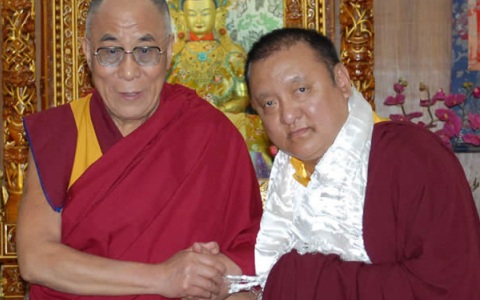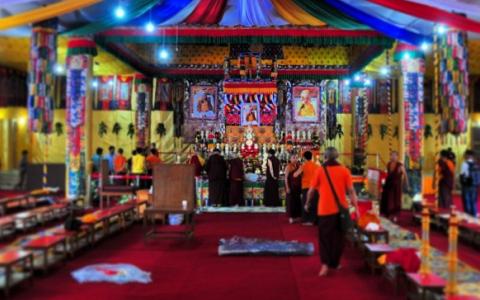Funeral fiasco shows Tibetans right to fear Chinese hand in Kathmandu
by - 6th August 2014

EVENTS leading up to the final rites of the much-loved Tibetan Buddhist guru, Shamar Rinpoche, were filled with drama.
Before the spiritial leader - who was based in Kathmandu - was buried there was much political toing and froing. This has raised questions about Nepal’s geopolitical limitations as well as the impact this might have on Tibetans living in the country.
After permission to bring back the remains of the Tibetan guru into Nepal was revoked by Nepal’s Home Ministry there was speculation about China’s involvement in the issue.
Pressure
But Nepal has denied any pressure from its northern neighbour.
Eventually, on 29 July Nepal’s Prime Minister Sushil Koirala intervened and allowed the remains to be brought in. The funeral took place in Kathmandu on 31 July.
The 62-year-old spiritual leader, the 14th Shamarpa of the Karma Kagyu school of Tibetan Buddhism, died of a heart attack on 11 June whilst teaching in Germany.
The Shamarpa is the third highest-ranking religious leader in the Tibetan community, preceded only by the Karmapa and the Dalai Lama.
The spiritual leader, who held a Bhutanese passport, had expressed his desire to be brought to his home monastery in Kathmandu for cremation.
Death
Following his death in Germany, the guru’s body was brought to New Delhi, where permission to transfer the remains to Nepal was granted by the Nepalese embassy.
But that decision was revoked after directives from Nepal’s Ministry of Home Affairs and the Ministry of Foreign Affairs.
The Nepalese government argued that since Nepal’s law did not permit foreigners to be brought into the country, it couldn’t make concession for the Bhutanese passport holder.
However, sources close to the government and other Tibetan leaders suggested that China had interfered and asked Nepal to not allow the funeral to take place in Kathmandu.

There were fears that the last rites could be used to galvanise the Tibetan community and start a protest movement against China, despite Rinpoche being known to have stayed away from political activities.
Nepal’s government vehemently denied the reports.
‘At the funeral of such a high ranking Tibetan spiritual leader, religion and politics are bound to mix and Nepal and China didn’t want to take chances’, said Shishir Ghimire, researcher at India’s Institute of Chinese Studies.
‘One China policy’
Nepal devoutly follows a ‘One China policy’ and cracks down with severity at protests that target its northern neighbour, dubbing any such movement as anti-Chinese.
While refuting media claims of Nepal being pressured by China, Laxmi Prasad Dhahal, spokesperson for Nepal’s Home Ministry said ‘that it was not appropriate to allow the transport of a foreign national’s body into the country for last rites.’
China’s growing influence in Nepal, especially where it concerns Tibetans, is of increasing concern for human rights advocates.
In a controversial report released by Human Rights Watch in April 2014, it was reporteded that Nepal had placed increasing restriction on Tibetans living in the country because of the growing Chinese pressure.
According to the report, there is a ‘de facto ban’ on political protests by Tibetans, restrictions on promoting Tibetan culture and religion, and routine abuses by Nepali security forces.
‘While Nepal continues to offer some protections to Tibetans, it is succumbing to Chinese pressure to limit the flow of Tibetans across the border and imposing restrictions on Tibetans in violation of its legal obligations. China disguises its demands as security concerns, but they are really just an extension of its repression in Tibet and aimed at making it harder for Tibetans to tell the world of their plight’ said Brad Adams, Asia director at Human Rights Watch.
Provocative
Nepal’s government slammed this report calling it ‘ill-founded, provocative and malicious’.
Nepal, a land-locked country, is surrounded by India on three sides and China in the north. Both contribute significantly to the economy and politics of the country.
Traditionally India viewed Nepal, like all its South Asian neighbours, as its back yard. But over the last decade China’s presence in Nepal has increased exponentially, which is making India wary.
China has emerged as the biggest investor in Nepal ahead of India. As of July 2012, 428 projects under Chinese investment came into operation in Nepal, creating 26,651 jobs. The number of visiting Chinese tourists has surged in the period 2009-2013 from 32,000 to almost 90,000.
Given China’s importance, Nepal has committed itself to stop anti-Chinese activities with a paranoia that is disconcerting.
As the regional giant of South Asia, India is also worried about losing its influence in Nepal to China.
‘The Himalayan boundary between China and India has been pierced and India feels that China’s growing presence in Nepal might undermine its security,’ says Ghimire.
Given Nepal’s geopolitical limitations, Tibetans living there fear they may face further curtailment.
